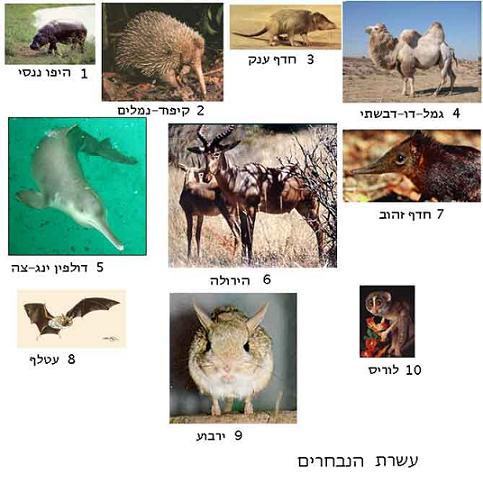What do the two-humped camel from Mongolia and the ant hedgehog from Australia have in common - both are unique species that have no relatives. A program at the Zoological Society of London will try to preserve them

Animal species in danger of extinction due to being "endangered species": mammals, insects, reptiles and others are in danger of extinction mainly due to environmental reasons, reasons caused by human-caused environmental changes,
In contrast, individual species become extinct also because they are "end-species", i.e. species that have reached a "dead end" in their evolutionary development, usually these are species that have no relatives, i.e. unique in their kind and therefore their chances of continuing to exist are slim.
For them, a unique conservation program was established by the Zoological Society of London (ZSL). The program is called the Evolutionary Distinct and Globally Endangered (Edge) project, where the target species are "species with historical evolution that are in danger of extinction and are not in existing conservation programs" for this purpose "endangered species" were defined as: species that have few "relatives" and are genetically unique.
The talk about a "one of a kind" of unique importance for conservation has been echoing for a long time, but it was difficult to realize the talk and turn it into a conservation plan. Now, following the development of the sorting method (the taxonomy) that shapes the
The "super tree" which shows the relationships between different species and makes it possible to identify the different species from an evolutionary point of view, it is possible to identify the endangered species and integrate them into the conservation plan on a global scale.
About 560 species have been identified that fit the program's definitions, the focus will be on one hundred of them.
To begin, 10 species were determined on which the "conservation spotlight" will be directed in 2007 and they are:
Pygmy hippopotamus / Hexaprotodon liberiensis – 1 – Dwarf hippopotamus – hundreds of individuals still live in central Africa.
Attenborough's long-beaked echidna / Zaglossus attenboroughi – 2 – hedgehog-ants – New Guinea, egg-laying mammal.
Hispaniolan solenodon / Solenodon paradoxus - 3 - giant hornbill - Haitian/Hispaniola, pushed out of its habitat by rats and cats.
Bactrian camel / Camelus bactrianus - 4 - two-humped camel - Mongolia, due to the entry of multi-engine vehicles is getting slaughtered.
Yangtze River dolphin / Lipotes vexillifer - 5 - Hingze dolphin - China, the pollution in the river causes its death.
Hirola antelope / Damaliscus hunteri - 6 - Hirola / Bobel - Northeast Africa, hunted for food and sold to luxury restaurants.
Golden-rumped elephant shrew / Rhynchocyon chrysopygus - 7 - Golden-rumped elephant shrew (rump) - Kenyan coast, suffers from suppression due to the destruction of its habitat.
Bumblebee bat / Craseonycteris thonglongyai - 8 - Bat - "tree-bee" - Western Thailand, considered the smallest mammal.
Long-eared jerboa / Euchoreutes naso - 9 - deserts of China and Mongolia, trampled and hunted.
Slender loris / tardigradus malabaricus - 10 = tiny loris - Sri Lanka, a tiny loris that lived about 20 million years ago.
The first step will be to send teams of experts (for each animal) to check the condition of the animal, local students will be "recruited" to function as "Edge conservation fellows" These will continue surveying and researching and designing the conservation policy. The program will be financed by scholarships as well as by donations from the public who will be able to follow the program through a "blog" on the Internet.
As a continuation, the members of the "Zoological Society" began to build a similar program for amphibian species, which they hope to implement in the near future.
According to Dr. Bailey, the founders of the program: "Mini-Katsa represent entire lines of evolution, therefore the loss of each of them is like the loss of the Mona Lisa."
Dr. Assaf Rosenthal, tour guide/leader in Africa and South America. For details, phone 0505640309 / 077-6172298, email assaf@eilatcity.co.il

7 תגובות
The square is a very cute life!!!!
I didn't know there were 9 squares left!! 🙁
My tiger is a very beautiful animal. Bite. Whose poop container is Zayn? Send the poop from me. Good luck.
To Lior
Those who do not know and understand the difference between species and type... will not understand,
The mountain gorillas belong to a single genus with one species and two subspecies,
(mountains / lowlands)
A uniqueness that puts the type and the species in danger.
What about the "Jewish people". This is also an endangered species. However, from this point of view, the Mona Lisa is not a suitable example, in my opinion the definition that "disappearance of this species is like the disappearance of the fountain of a lake in Dizengoff Square" or for example: "disappearance of the program Kohav Nold" is more relevant.
In the last expedition that tried to estimate how many of them remained, not a single detail of the Ying Tze dolphin was found. Some say it is extinct.
I'm afraid that this sentence in the article is not quite true:
"Usually these are species that have no relatives, i.e. unique in their kind, so their chances of continuing to exist are slim."
The uniqueness of the species is not the reason for their being in danger of extinction, but the reason for the increased interest in their conservation. The parent gorillas have several related species, and XNUMX are in serious danger of extinction.
Definitely a welcome project.
It's a shame that there is money to collect and save the information from only ten species out of the 560 that were defined as edge species.
It is of utmost importance to preserve the species and prevent their disappearance. At the very least, one should try and preserve gametes so that in the future there will be the tools and the option to bring the extinct species back into the world.